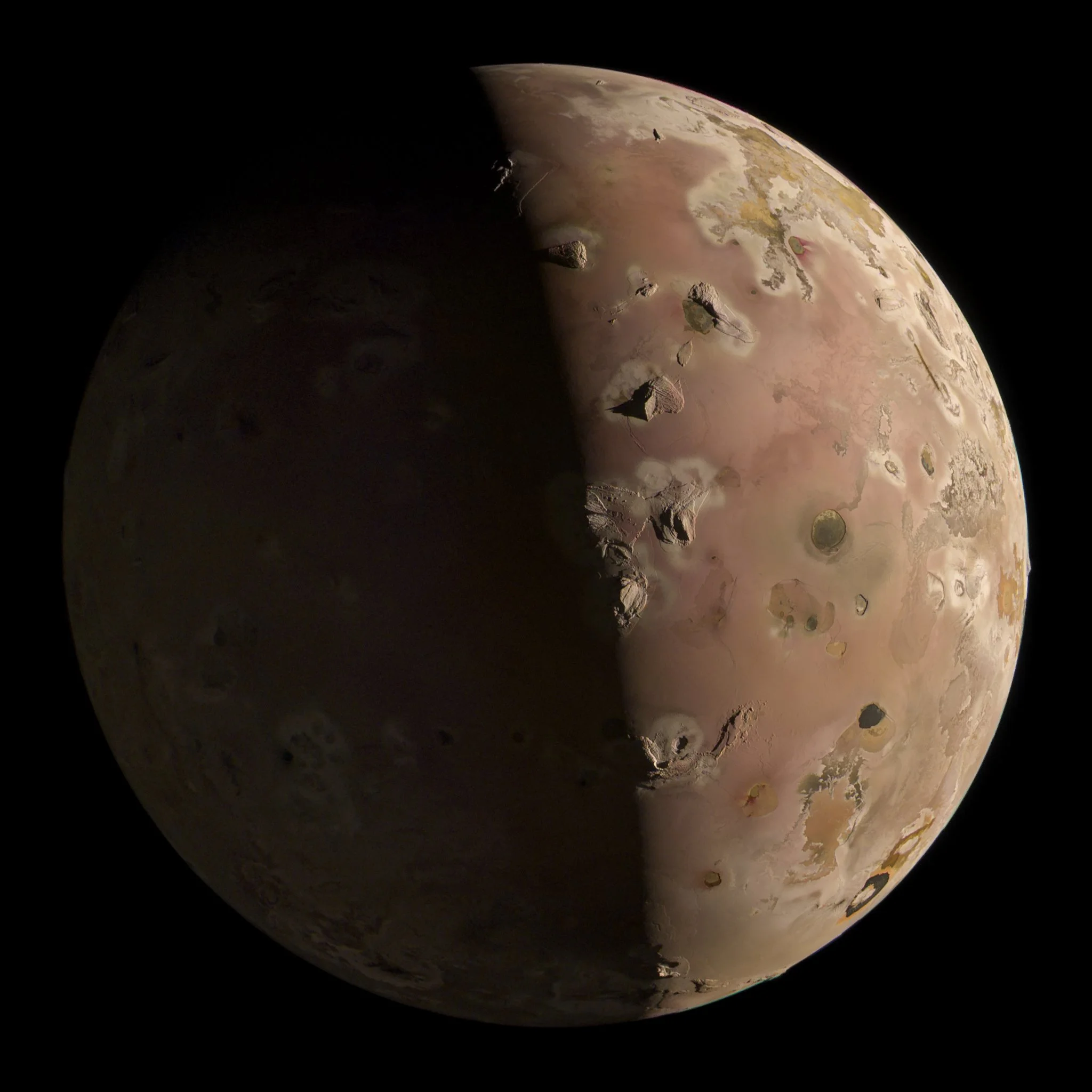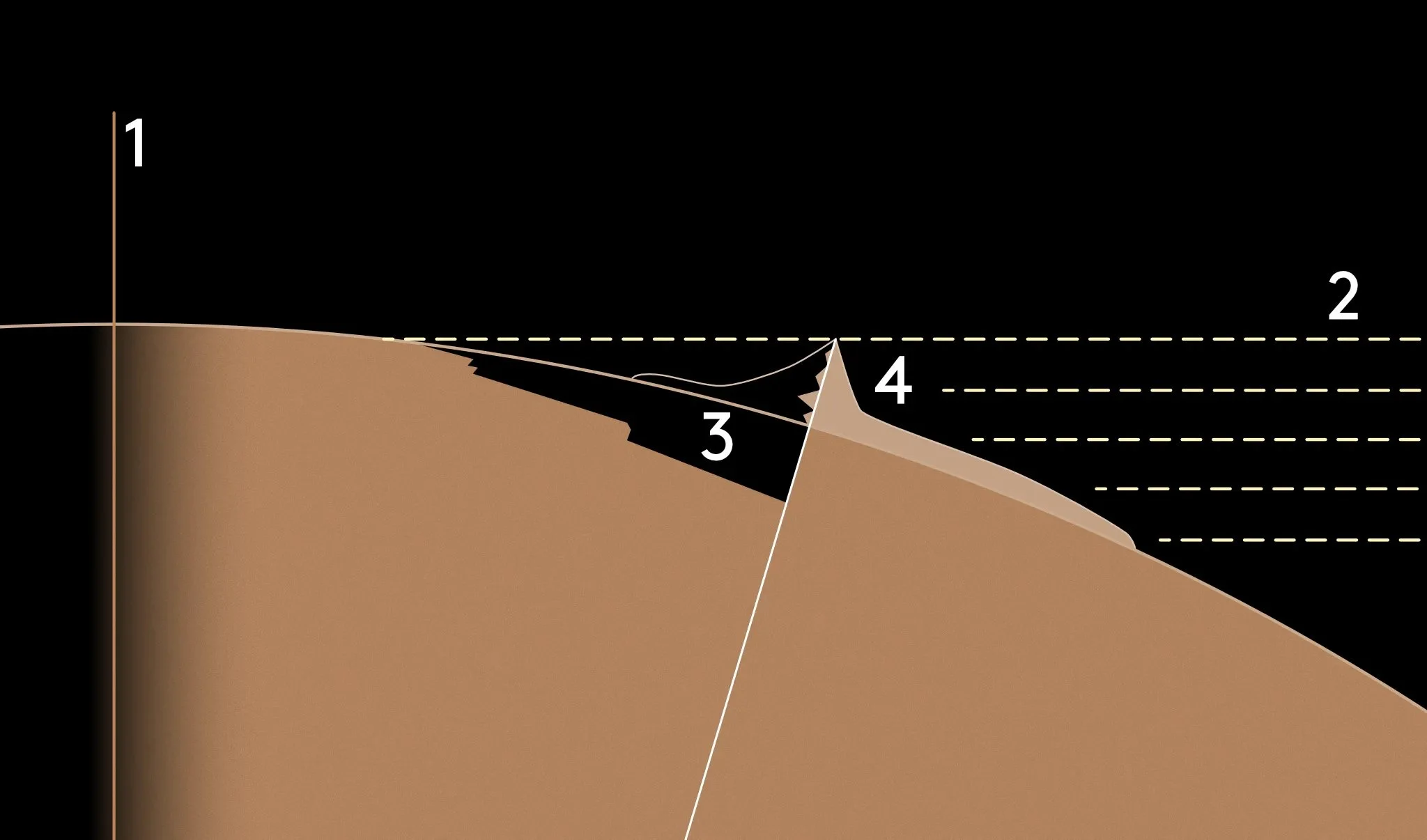Hidden in the Shadow
The True Shape of Io's Steeple Mountain.
We set out on a mission to bring Jupiter’s volcanic moon Io into your living room, crafting an awesome diorama of its famously sharp and pointy "Steeple" Mountain. But as we dove deeper into Io’s weird geology, we stumbled upon a cosmic exaggeration.
The popular depiction IO’s famous "Steeple Mountain” (officially dubbed Dis Mons by the International Astronomical Union) might be more science fiction than science fact.
When we compared the iconic illustration to actual scientific estimates, we discovered the mountain's proportions had been significantly stretched—making it taller and sharper than reality allows.
This exaggerated depiction isn't clearly flagged anywhere prominent—only casually mentioned on Io’s Wikipedia page. So, in the interests of interplanetary accuracy, to set the record straight we’ve created our own artist’s impression of Dis Mons, scaled to match what the Junocam aboard NASA’s Juno spacecraft actually observed. It might be slightly less "steeple-y," but it's astronomically closer to reality!
As of now, detailed global maps don't yet show Dis Mons in high resolution, but Junocam's recent snapshots are helping us bring you an accurate piece of space geology—minus the cosmic hype.
Why the original artist’s impression doesn’t convey Steeple Mtn’s true shape
In the original photograph of Dis Mons captured by the Juno mission, the shadow cast by the mountain appears long and steep, misleading viewers into thinking that the mountain itself is similarly steep. But a closer analysis of the actual lighting conditions reveals a different story.
When the photo was captured by Juno, Dis Mons was located near the terminator—the line that divides the daylit side of the moon from its night side. At this position, the Sun's rays strike the surface nearly parallel, which causes elongated shadows that exaggerate the perceived steepness of objects.
Given the known data that Dis Mons reaches a height of about 7 kilometers and spans a base of 150 kilometers, it is clear that the mountain cannot be as steep as initially depicted. If the mountain's height wasn't purposefully exaggerated to demonstrate subtle terrain features, the artist probably relied on the visual impact of this shadow in the photograph, interpreting it as a sign of the mountain’s steepness.
However, by carefully examining the extent of the shadow, we can reverse-engineer the geometry of the scene. By projecting a ray from the tip of the shadow back to the position of the Sun, we can determine the mountain's true height. Drawing a perpendicular line from the projected peak onto the moon's spheroid provides a more accurate geometric estimate of the mountain's elevation:
1 - terminator line; 2 - light rays from the Sun; 3 - shadow of the mountain; 4 - mountain peak. The curvature of Io is exaggerated for illustrative purposes
Additionally, the surrounding terrain in the artwork appears unusually flat, which is inconsistent with the curvature dictated by Io's small radius. The actual surface of Io would show more pronounced curvature.
How we created the new look
We used a new global map of Io compiled from the Juno mission's images by Gerald Eichstädt, Jason Perry and John Rogers.
Applying it back to a sphere, we oriented the map to the sunlight, and treated the shadow as it was cast on a perfect sphere (though Io, like all celestial bodies, isn’t really a perfect sphere, the differences were negligible for the purpose of this reconstruction). Having a projection of the shadow and a top view of the mountain allowed the three-dimensional shape of the ridge to be reconstructed.
The next step, to recreate the elevation profiles of the flatter parts of the mountain, was achieved by adjusting and detailing a rough 3D model in the reconstructed lighting conditions to achieve the pattern of light and shadow similar to those from the photograph of the object. This could, in a sense, be called manual photoclinometry.
However, computational photoclinometry could produce more scientifically accurate results; this approach was used along with some artistic interpretation to imagine further details not visible in the original data. Close-ups of other Ionian mountains taken by the Galileo mission were used as a reference for details, along with attempts to understand the processes that resulted in such a structure.
What energizes Io's volcanic activity?
Io is extremely geologically active, and its relentless volcanic activity is primarily driven by tidal friction resulting from gravitational interactions with Jupiter. Io experiences continuous tidal deformation, because its orbit is slightly elliptical rather than perfectly circular. As the moon moves closer to and farther from Jupiter along its orbit, the varying gravitational force causes internal flexing, generating heat through friction.
Although Jupiter’s tidal forces alone would normally act to circularize Io’s orbit over time, its eccentricity is sustained by the gravitational influence of Europa and Ganymede. These three moons are locked in a Laplace resonance, a gravitational relationship that prevents Io’s orbit from becoming perfectly circular. The periodic gravitational tugs from Europa and Ganymede subtly perturb Io’s motion, counteracting the natural damping effect of Jupiter’s tides, and ensuring that Io continues to experience tidal heating over geological timescales. Astonishingly, Io’s volcanoes have been active for billions of years.
How mountains form on Io
Io’s tectonics are vastly different from those found on Earth, where standard vulcanism and plate tectonics form the majority of mountains. Io’s aeons of extreme volcanic activity continuously resurface the moon, depositing vast amounts of material on its crust. Over time, this buildup forces the crust downward into the interior, generating pervasive compressional stresses. When the lithosphere reaches a breaking point, sections of the crust are thrust upward along deep faults, much like a rug buckling when compressed from both sides.
Io's mountains tend to form away from active volcanic regions, since the stress is relieved not by eruptions but through tectonic uplift. Nonetheless, mountains are frequently associated with Ionian volcanic craters called patera, which suggests that mountain formation may provide pathways for magma to reach the surface.
This process, in which mountains emerge as a result of deep-seated faulting rather than volcanic buildup, was described by Bland, M. T., & McKinnon, W. B. in their study Mountain building on Io driven by deep faulting (Nature Geoscience, 9(6), 429–432).
Dis Mons exhibits clear evidence of such tectonic processes. Its ridge appears to be a block of crust that was thrust upward due to deep-seated faulting. The relatively flat portion of the mountain consists of crushed crustal material, forming visible surface wrinkles as a result of compression. To the South of the mountain, a somewhat circular, mildly uplifted section of crust can be seen, encircled by a fracture—likely a remnant of the stresses that shaped the terrain. Additionally, to the west of the mountain, within its shadow, there are signs of what appears to be an eruption. The coloration suggests sulfur-rich material emerging through fractures formed during the uplift process.
1 - ridge; 2 - crushed crustal material; 3 - a mildly uplifted block of crust; 4 - a suspected secondary eruption.
In summary
It turns out that Io, Jupiter’s moon, doesn’t resemble a mace ball with pointy spikes; instead, it has more of a pizza-like appearance, with large, relatively smooth surface features. We believe it’s important to restore a more realistic view of this fascinating celestial object to enhance public understanding and perception.
We’re also working on creating a physical model that captures this spectacular illusion, which will be available soon.
Konstantin Gurianov
Product Innovation Strategist at Inquisitive
References
Original artist’s concept of Io's 'Steeple Mountain': https://www.jpl.nasa.gov/images/pia26294-ios-steeple-mountain-artists-concept/
Dis Mons at USGS website: https://planetarynames.wr.usgs.gov/Feature/16368
Image of the object taken by the Juno spacecraft: https://www.missionjuno.swri.edu/junocam/processing?id=15942
Junocam Map of Io: https://www.missionjuno.swri.edu/junocam/processing?id=16188
Bland, M., McKinnon, W. Mountain building on Io driven by deep faulting. Nature Geosci 9, 429–432 (2016). https://doi.org/10.1038/ngeo2711 https://www.nature.com/articles/ngeo2711
Feel free to use these images and videos in your own projects. All we ask is that you credit us at Inquisitive when you share or publish them.




